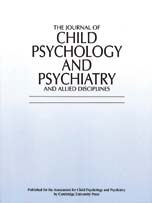Crossref Citations
This article has been cited by the following publications. This list is generated based on data provided by
Crossref.
Fallone, Gahan
Acebo, Christine
Arnedt, J. Todd
Seifer, Ronald
and
Carskadon, Mary A.
2001.
Effects of Acute Sleep Restriction on Behavior, Sustained Attention, and Response Inhibition in Children.
Perceptual and Motor Skills,
Vol. 93,
Issue. 1,
p.
213.
Gozal, David
Wang, Mei
and
Pope, Dennis W.
2001.
Objective Sleepiness Measures in Pediatric Obstructive Sleep Apnea.
Pediatrics,
Vol. 108,
Issue. 3,
p.
693.
Frolich, Jan
Wiater, Alfred
Lehmkuhl, Gerd
and
Niewerth, Hansjorg
2001.
The Clinical Value of the Maintenance of Wakefulness Test (MWT) in the Differentiation of Children with Attention Deficit Hyperactivity Disorder (ADHD) and Disorders of Excessive Somnolence. Der klinische Einsatz des Maintenance of Wakefulness Tests (MWT) in der -Differentialdiagnostik von Aufmerksamkeits- und Vigilanzstorungen im Kindesalter.
Somnologie,
Vol. 5,
Issue. 4,
p.
141.
FALLONE, GAHAN
2001.
EFFECTS OF ACUTE SLEEP RESTRICTION ON BEHAVIOR, SUSTAINED ATTENTION, AND RESPONSE INHIBITION IN CHILDREN.
Perceptual and Motor Skills,
Vol. 93,
Issue. 5,
p.
213.
Konofal, E
Lecendreux, M
and
Mouren-Siméoni, M.C
2002.
Mise au point des études cliniques sur le rapport « veille-sommeil » dans le trouble déficit de l’attention/hyperactivité de l’enfant.
Annales Médico-psychologiques, revue psychiatrique,
Vol. 160,
Issue. 2,
p.
105.
Hagenah, U.
2002.
Schlafstörungen bei kinder- und jugendpsychiatrischen Erkrankungen.
Zeitschrift für Kinder- und Jugendpsychiatrie und Psychotherapie,
Vol. 30,
Issue. 3,
p.
185.
Fallone, Gahan
Owens, Judith A.
and
Deane, Jennifer
2002.
Sleepiness in children and adolescents: clinical implications.
Sleep Medicine Reviews,
Vol. 6,
Issue. 4,
p.
287.
Kass, Steven J.
Wallace, J. Craig
and
Vodanovich, Stephen J.
2003.
Boredom proneness and sleep disorders as predictors of adult attention deficit scores.
Journal of Attention Disorders,
Vol. 7,
Issue. 2,
p.
83.
O’Brien, Louise M.
Holbrook, Cheryl R.
Mervis, Carolyn B.
Klaus, Carrie J.
Bruner, Jennifer L.
Raffield, Troy J.
Rutherford, Jennifer
Mehl, Rochelle C.
Wang, Mei
Tuell, Andrew
Hume, Brittany C.
and
Gozal, David
2003.
Sleep and Neurobehavioral Characteristics of 5- to 7-Year-Old Children With Parentally Reported Symptoms of Attention-Deficit/Hyperactivity Disorder.
Pediatrics,
Vol. 111,
Issue. 3,
p.
554.
Chu, Sidney
2003.
Attention deficit hyperactivity disorder (ADHD) part one: a review of the literature.
British Journal of Therapy and Rehabilitation,
Vol. 10,
Issue. 5,
p.
218.
CHERVIN, RONALD D.
DILLON, JAMES E.
ARCHBOLD, KRISTEN HEDGER
and
RUZICKA, DEBORAH L.
2003.
Conduct Problems and Symptoms of Sleep Disorders in Children.
Journal of the American Academy of Child & Adolescent Psychiatry,
Vol. 42,
Issue. 2,
p.
201.
Frölich, J.
Lehmkuhl, G.
and
Wiater, A.
2003.
Schlafstörungen bei hyperkinetischen Kindern - Zusammenhänge zu Arousalstörungen, differentialdiagnostische Abgrenzungen und Komorbiditäten.
Zeitschrift für Kinder- und Jugendpsychiatrie und Psychotherapie,
Vol. 31,
Issue. 2,
p.
133.
O'Brien, Louise Margaret
Ivanenko, Anna
Crabtree, Valerie McLaughlin
Holbrook, Cheryl Robin
Bruner, Jennifer Leigh
Klaus, Carrie Joann
and
Gozal, David
2003.
Sleep Disturbances in Children with Attention Deficit Hyperactivity Disorder.
Pediatric Research,
Vol. 54,
Issue. 2,
p.
237.
Kirov, Roumen
Kinkelbur, Joerg
Heipke, Susanne
Kostanecka‐Endress, Tatiana
Westhoff, Moritz
Cohrs, Stefan
Ruther, Eckart
Hajak, Goran
Banaschewski, Tobias
and
Rothenberger, Aribert
2004.
Is there a specific polysomnographic sleep pattern in children with attention deficit/hyperactivity disorder?.
Journal of Sleep Research,
Vol. 13,
Issue. 1,
p.
87.
Cohen-Zion, Mairav
and
Ancoli-Israel, Sonia
2004.
Sleep in children with attention-deficit hyperactivity disorder (ADHD): a review of naturalistic and stimulant intervention studies.
Sleep Medicine Reviews,
Vol. 8,
Issue. 5,
p.
379.
Fallgatter, Andreas J
Ehlis, Ann-Christine
Seifert, Juergen
Strik, Werner Konrad
Scheuerpflug, Peter
Zillessen, Klaus Eckard
Herrmann, Martin J
and
Warnke, Andreas
2004.
Altered response control and anterior cingulate function in attention-deficit/hyperactivity disorder boys.
Clinical Neurophysiology,
Vol. 115,
Issue. 4,
p.
973.
SCHWARTZ, GEORGE
AMOR, LEILA BEN
GRIZENKO, NATALIE
LAGEIX, PHILIPPE
BARON, CHANTAL
BOIVIN, DIANE B.
and
JOOBER, RIDHA
2004.
Actigraphic Monitoring During Sleep of Children With ADHD on Methylphenidate and Placebo.
Journal of the American Academy of Child & Adolescent Psychiatry,
Vol. 43,
Issue. 10,
p.
1276.
Millman, Richard P.
2005.
Excessive Sleepiness in Adolescents and Young Adults: Causes, Consequences, and Treatment Strategies.
Pediatrics,
Vol. 115,
Issue. 6,
p.
1774.
Herman, John H.
and
Sheldon, Stephen H.
2005.
Principles and Practice of Pediatric Sleep Medicine.
p.
327.
Dobler, V.B.
Anker, S.
Gilmore, J.
Robertson, I.H.
Atkinson, J.
and
Manly, T.
2005.
Asymmetric deterioration of spatial awareness with diminishing levels of alertness in normal children and children with ADHD.
Journal of Child Psychology and Psychiatry,
Vol. 46,
Issue. 11,
p.
1230.


